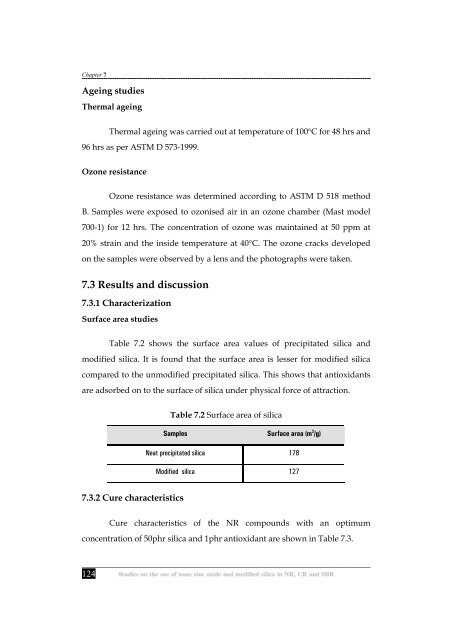Studies on the use of nano zinc oxide and modified silica in NR, CR ...
Studies on the use of nano zinc oxide and modified silica in NR, CR ...
Studies on the use of nano zinc oxide and modified silica in NR, CR ...
You also want an ePaper? Increase the reach of your titles
YUMPU automatically turns print PDFs into web optimized ePapers that Google loves.
Chapter 7<br />
Age<strong>in</strong>g studies<br />
Thermal age<strong>in</strong>g<br />
124<br />
Thermal age<strong>in</strong>g was carried out at temperature <strong>of</strong> 100°C for 48 hrs <strong>and</strong><br />
96 hrs as per ASTM D 573-1999.<br />
Oz<strong>on</strong>e resistance<br />
Oz<strong>on</strong>e resistance was determ<strong>in</strong>ed accord<strong>in</strong>g to ASTM D 518 method<br />
B. Samples were exposed to oz<strong>on</strong>ised air <strong>in</strong> an oz<strong>on</strong>e chamber (Mast model<br />
700-1) for 12 hrs. The c<strong>on</strong>centrati<strong>on</strong> <strong>of</strong> oz<strong>on</strong>e was ma<strong>in</strong>ta<strong>in</strong>ed at 50 ppm at<br />
20% stra<strong>in</strong> <strong>and</strong> <strong>the</strong> <strong>in</strong>side temperature at 40°C. The oz<strong>on</strong>e cracks developed<br />
<strong>on</strong> <strong>the</strong> samples were observed by a lens <strong>and</strong> <strong>the</strong> photographs were taken.<br />
7.3 Results <strong>and</strong> discussi<strong>on</strong><br />
7.3.1 Characterizati<strong>on</strong><br />
Surface area studies<br />
Table 7.2 shows <strong>the</strong> surface area values <strong>of</strong> precipitated <strong>silica</strong> <strong>and</strong><br />
<strong>modified</strong> <strong>silica</strong>. It is found that <strong>the</strong> surface area is lesser for <strong>modified</strong> <strong>silica</strong><br />
compared to <strong>the</strong> un<strong>modified</strong> precipitated <strong>silica</strong>. This shows that antioxidants<br />
are adsorbed <strong>on</strong> to <strong>the</strong> surface <strong>of</strong> <strong>silica</strong> under physical force <strong>of</strong> attracti<strong>on</strong>.<br />
7.3.2 Cure characteristics<br />
Table 7.2 Surface area <strong>of</strong> <strong>silica</strong><br />
Samples Surface area (m 2 /g)<br />
Neat precipitated <strong>silica</strong> 178<br />
Modified <strong>silica</strong> 127<br />
Cure characteristics <strong>of</strong> <strong>the</strong> <strong>NR</strong> compounds with an optimum<br />
c<strong>on</strong>centrati<strong>on</strong> <strong>of</strong> 50phr <strong>silica</strong> <strong>and</strong> 1phr antioxidant are shown <strong>in</strong> Table 7.3.

















